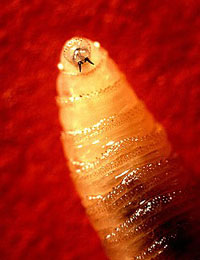Tiny parasite; big problem

Almost 2,000 livestock producers and industry-affiliated participants attended the event hosted by the Texas A&M AgriLife Extension Service and the Texas A&M College of Agriculture and Life Sciences Department of Animal Science.
“We are not in crisis mode; we are in awareness and preparedness mode,” said T.R. Lansford, DVM, Texas Animal Health Commission deputy executive director and assistant state veterinarian, Bryan-College Station. “This has to be a community effort from producers to government agencies, because as long as New World screwworms are in Mexico, Texas has an increased risk.”
Planning for eradication – again
Lansford said New World screwworms will require all hands on deck. The name of the game will be mitigation and control until the most effective eradication method — sterile fly release – is able to ramp up adequate production.
Screwworms were successfully eradicated from the U.S. in 1966 using the sterile insect technique. However, current sterile fly production is approximately 110 million flies per week in Panama, and between 400 million and 500 million per week are needed to control the current outbreak.
Another plant is planned, with a sterile fruit fly production facility in Chiapas, Mexico, being converted to sterile screwworm fly production. However, the earliest it is expected to open is July 2026, and it will produce only 60 million to 100 million flies per week.
“Eradication efforts can cost stakeholders tens of millions of dollars, but freedom from the pest provides approximately $1 billion in direct benefits to livestock producers and about $3.7 billion in benefits to the general economy annually,” Lansford said.
Panel highlights concerns
When screwworms were a daily chore back in the 1950s and 1960s, livestock operations had more horses, hired hands and even dogs that could smell the infections to help with the daily monitoring, gathering and treatment of livestock. But those things are not in place today, according to a New World Screwworm panel at the short course.
The panel included Jim McAdams, rancher and past National Cattlemen’s Beef Association president; Joe Paschal, Ph.D., AgriLife Extension livestock specialist emeritus and ranching and genetics consultant; Alberto Banuet, Ph.D., a rancher from Yucatan, Mexico, and Ron Gill, Ph.D., AgriLife Extension livestock specialist and professor in the Department of Animal Science.
They expressed concerns that many smaller operations lack the labor and facilities to manage screwworms if they reach the U.S., and even larger operations that infrequently monitor or handle their livestock may struggle to do so.
McAdams, who had firsthand experience with screwworms in the 1950s and 1970s when they reappeared, said to mitigate the risk in livestock operations, “we need to get our mind right. All we can control is what we do. We need to start preparing our facilities and make it where if and when it gets here, it is as easy on you as possible.”
Producers need to ensure they have the ability and facilities in place to catch the animals and check them or treat them in the least stressful manner. They need to “train” their cattle so they can handle them and get them treated, he added.
Preparedness steps
Internal and external working groups have developed a “three-legged stool” approach to preparedness, which includes treatment, surveillance and movement control.
For producers, preparedness begins with monitoring animals regularly for signs of myiasis or maggots. Any suspicious maggot cases should be reported to the Texas Animal Health Commission for livestock and pets at 800-550-8242 or the Texas Parks and Wildlife Department for wildlife at 512-389-4505, or to an accredited veterinarian or an AgriLife Extension agent. Do not move the animal; let the individual reporting agency representative come to the animal’s location.
AgriLife Extension’s New World screwworm webpage has new fact sheets and a technical bulletin to provide more detailed information about the New World screwworm and the science behind the pest and destruction it causes.
The best mitigation steps for livestock operations include:
- Routinely inspect livestock for maggots, whether in pastures, pens, prior to or post transportation.
- Prevent wounds with proper facility maintenance. Treat any wounds promptly to prevent and/or reduce infestations.
- Schedule birthing of animals and other procedures that would cause an opening in the skin during the cooler months when fly populations are low.
While parts of the process could be uncomfortable in the future, such as quarantines, Lansford said there is a commitment to continuity of operations. To ensure continuity for most operations, it is paramount that producers who see something say something to aid in early identification and minimize the spread.


